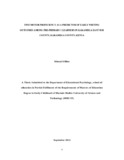FINE MOTOR PROFICIENCY AS A PREDICTOR OF EARLY WRITING OUTCOMES AMONG PRE-PRIMARY 1 LEARNERS IN KAKAMEGA EAST SUB COUNTY, KAKAMEGA COUNTY, KENYA
Abstract
Readiness to learn is beneficial to pre-school learners as it entails specific skills acquisition such as intellectual, social, and motor skills required for learning and they are also connected to later academic outcomes and school completion. Fine motor proficiency (fluency in use of finger muscles) not only facilitates proper handwriting, better coordination of small muscles in movement with the eyes, hand and fingers but also manipulating writing and play tools (Arango 2001). Children who miss this kind of stimulation manifest behavioural, socialization, and cognitive difficulties which affects their later academic outcomes (Goodness 7 Sianesi 2005). The fact that there have been studies on numeracy and literacy skills in general, there hasn’t been any studies on writing as a single component which means that writing should be looked into since it is the basis of learning. Thus, this study examined the influence of fine motor proficiency on writing development among pre-primary 1 learners in Kakamega East sub-county, Kakamega county, Kenya. The study objectives were to establish the influence of fine motor competency on pen-handling, the impact of fine motor expertise on legible writing, and the association between fine motor competency and letter formation among pre-primary 1 learners in Kakamega East sub-county. The study utilised Prior’s sociocultural which addressed the writing components and Kephart’s theory which dealt with fine muscle development and the exercises that improve the same due to insufficiency of a single theory in outlining both fine motor and writing outcomes. The research utilized a survey research design as a mechanism of identifying the association between the dependent and independent variables. The tools used for the study were questionnaires, interview schedules, observation checklist, and document analysis guide. The study’s target population was 6 public preschools where 6 ECDE head teachers were sampled using purposive technique with three hundred and eighty-five parents who were proportionately sampled. In order to test for the research protocol, piloting of the research tools was done where content validity was utilized to test for the validity of the instruments. Scientific testing of the research tools using the test-retest method was done with experts from Masinde Muliro University of Science and Technology (MMUST) to establish the feasibility of the study tools at r=0.7. Data was analysed in words, descriptively and inferentially using means, their percentages and linear regression analysis supported by Package for Social Sciences (SSPS). In determining the association between the dependent and independent variables, linear regression analysis and Anova test were used. Also, Pearson correlation was used in hypothesis testing. The regression analysis results indicated that pen-handling, writing legibility and letter formation are significant in explaining variations in fine motor proficiency among pre-primary 1 learners. The results were supported with interview, observation, and document analysis guide. The study findings indicated a strong positive linear relationship shown by the gradient of the equation ranging from 0.1- 0.5. The study concluded that fine motor proficiency has an effect on pre-primary 1 learners writing outcomes. The study recommended the county government of Kakamega to organize trainings and seminars to equip preschool teachers with relevant skills to enhance learners writing outcomes.
Collections
- School of Education [70]

